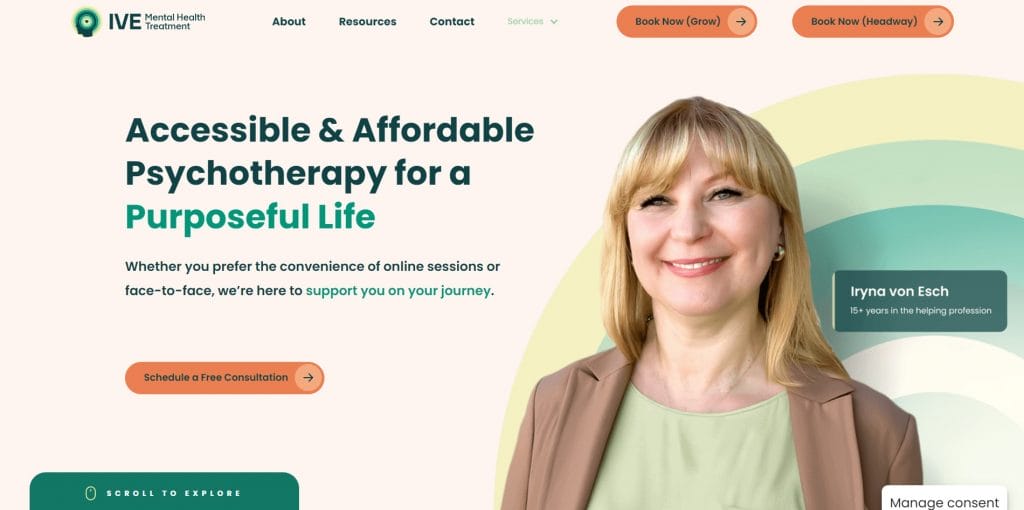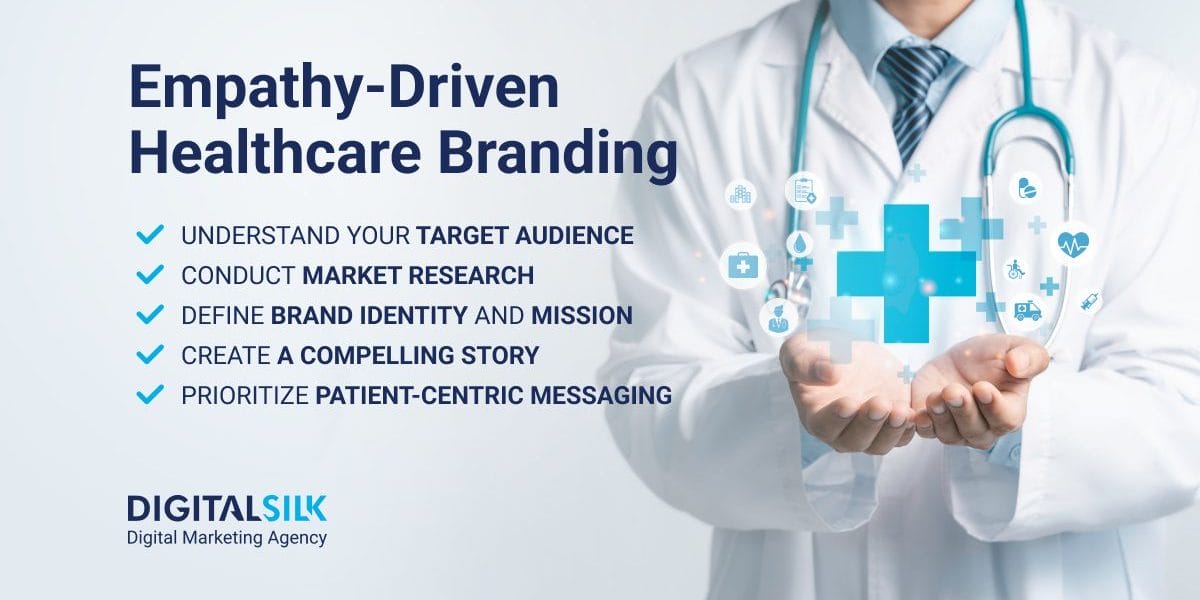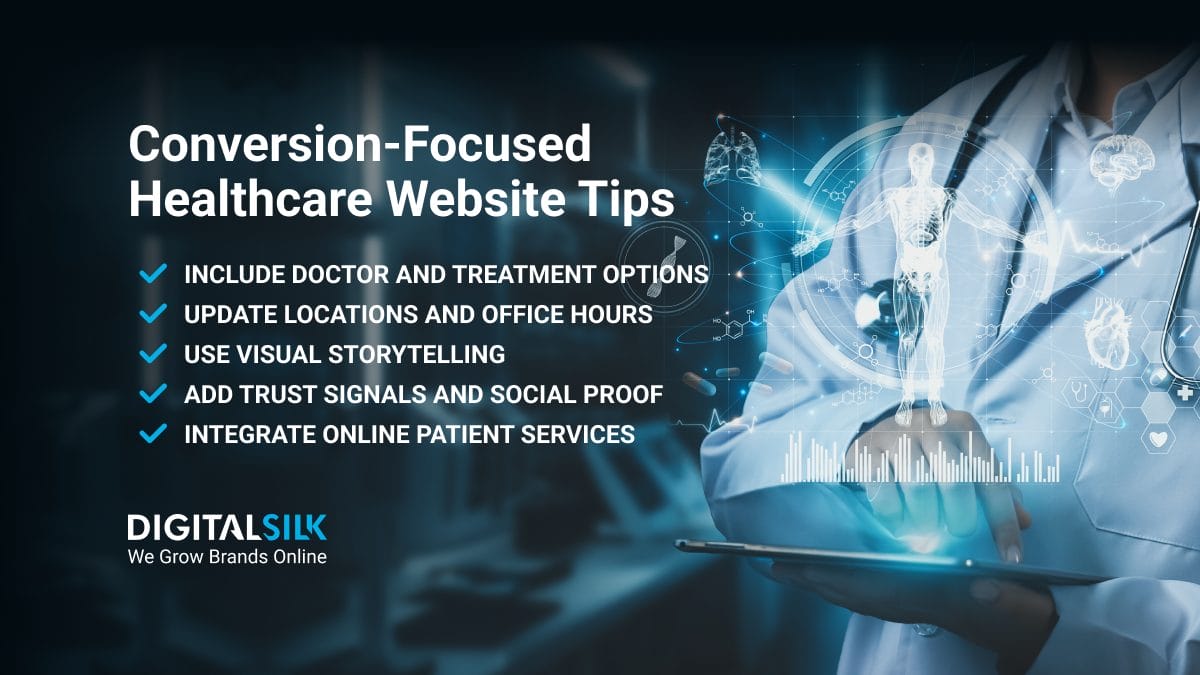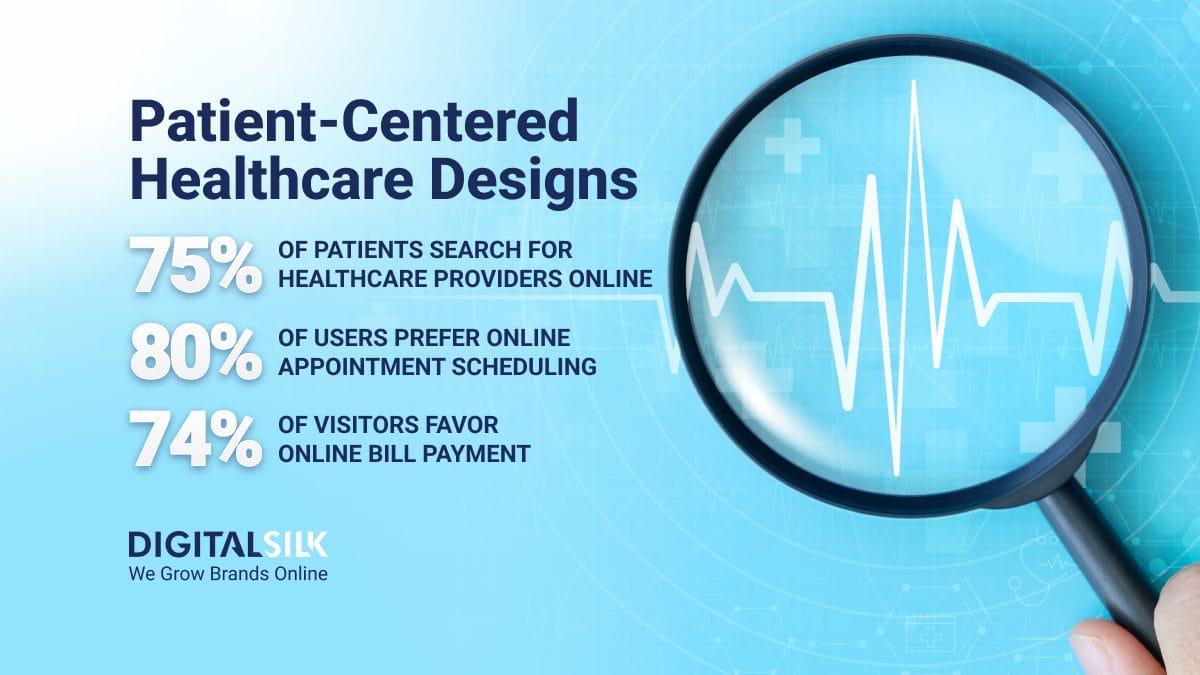Healthcare Branding: Key Highlights
-
Patient-first digital experiences convert: Tailored insights and messaging build trust and forge strong patient connections.
-
Digital transformation drives growth: Leveraging telehealth, AI and data analytics personalizes care and streamlines patient engagement.
-
Authentic storytelling builds loyalty: Genuine patient testimonials and emotionally-driven visuals create relatable, impactful brand narratives.
With 84% of patients using both online and offline resources to research hospitals, the first impression your brand makes can significantly influence their choices.
While the quality of care you provide shapes patient satisfaction, your branding strategy is what gets patients through the door in the first place.
In this article, we’ll list 10 steps to creating an impactful healthcare branding strategy, discuss its importance in this ever-evolving industry and offer actionable tips for navigating common obstacles.
Let’s transform how patients perceive and connect with your healthcare organization.
How To Create A Healthcare Branding Strategy
With 61% of U.S. adults looking for medical information on the internet, you can follow the latest branding trends to create memorable, empathetic and informative experiences that engage existing clients and attract new ones.
Below, we’ve compiled a step-by-step guide to effective branding in the healthcare industry, based on their market impact, consumer trust and long-term ROI.
Step 1. Understand Your Target Audience
Only 42% of businesses have definitive data on their target audience, which directly impacts their ability to connect, engage and convert potential clients.
Patients today have more access to information than ever before.
They look for brands that speak to their realities and offer clear, compassionate advice rather than generic messages.
Learning about your target audience goes beyond basic demographics — it involves learning about the unique challenges patients face, their concerns about treatment options and even the emotional journeys they undergo when seeking care.
When you analyze your audience, you uncover the subtle nuances of their expectations to inform your core brand guidelines.
You can gain insights into your target market by:
- Engaging in direct conversations: Encourage feedback through surveys, focus groups or online communities.
- Mapping the patient journey: Create a visual map of user journeys, pain points and value equations to identify touchpoints where clear and empathetic information can help guide them.
- Analyzing demographics and psychographics: Analyze your target market’s lifestyle, values, behaviors and even fears to tailor your messaging to offer tangible solutions to their needs.
For instance, Kaiser Permanente highlights its patient-centric approach by emphasizing its end-to-end care services and empathetic communication across all platforms and touchpoints.
Step 2. Conduct Comprehensive Market And Industry Research
The healthcare services market is expected to reach $22.57 trillion in value by 2031.
This industry is dynamic, constantly reshaped by technological innovations, policy changes and patient expectations.
To develop impactful, relevant and timely messaging, it’s important to assess your market positioning, competitor strategies and current market trends.
To conduct comprehensive market and industry research, you should:
- Analyze market trends: Anticipate changes in the industry and pay attention to broader movements such as rising healthcare costs, increased access to information and demand for personalized care. Review industry reports, academic studies and market analysis reports from reliable sources.
- Study competitor strategies: How are competitors positioning their brands? What technologies are they adopting? How does your brand differ in terms of services, pricing or customer experience?
- Adopt emerging technologies: Keep track of tech advancements that streamline, personalize or make healthcare services more accessible.
Step 3. Define Brand Identity And Mission
45% of consumers would stop interacting with brands they don’t share the same values with.
Healthcare, unlike many other industries, relies heavily on patient trust and emotional connection.
Users don’t just choose a provider for a product — they connect with a promise of quality care, empathy and reliability.
Your brand identity tells your audience who you are, what you stand for and why they should trust you.
This transparent approach guides how the organization presents itself in communications, influences patient care philosophies and shapes internal culture.
You can establish a signature identity by adopting the following healthcare branding strategies:
- Identifying core values that align with your mission and vision
- Establishing a comprehensive brand book with key elements
- Aligning internal culture with brand values
- Clearly communicating your Unique Value Proposition
- Consistently delivering on your brand promise and mission
For instance, Mount Sinai Health System draws on long-standing values of compassion and community to act as “a beacon and a lifeline” for all its patients, with an unrelenting focus on patient experience and research-driven healthcare.
Step 4. Craft A Compelling Brand Voice And Story
With close to 3 million healthcare and social assistance businesses in the U.S. in 2024, patients are spoiled for choice and can afford to be discerning.
A powerful brand voice and story differentiate your institution from competitors by telling an authentic, engaging narrative that resonates with patients on a personal level.
These two elements are the heartbeat of your healthcare brand — they shape how your audience perceives you, what they remember about you and why they choose you over others.
Your brand voice is more than a tone in communications, but a reflection of your organization’s personality, which translates into trust, empathy and loyalty.
Telling a story helps audiences relate to an organization’s mission and vision and turns abstract values into relatable narratives.
You can effectively implement these strategies through:
- Identifying key messaging pillars to reflect your brand personality and values
- Using authentic and human language without jargon or technical vocabulary
- Sharing meaningful, impactful stories to illustrate your expertise
- Creating a consistent tone across all channels and platforms
- Empathizing with your audience’s pain points and offering solutions
Step 5. Use Emotionally-Driven Visuals And Prioritize Patient-Centric Messaging
55% of impressions users have of brands are based on visual elements.
Images, colors, logos and other graphic assets can bypass the healthcare industry’s traditional complex and transactional messaging by prioritizing emotion and enhancing the patient experience.
These visual elements speak to humanity’s hope and resilience in a language that words alone oftentimes fail to replicate.
They invite patients into a shared space where empathy is at the forefront and encourage them to feel seen, heard and cared for.
Moreover, patient-centric messaging focuses on creating content that speaks directly to their concerns and experiences, such as discussing treatment options, side effects and recovery openly and honestly.
Whether it’s on a website, in a brochure or face-to-face, using a warm and empathetic tone can make patients feel truly cared for, which can help ease any nerves they might have about getting treatment.
It also means using inclusive language and considering diverse perspectives, such as those from different cultural backgrounds or individuals with disabilities.
For instance, the Cleveland Clinic features relatable, diverse and emotionally charged patient references across all platforms to reinforce the institution’s commitment to inclusivity and compassion.
Step 6. Incorporate Patient Testimonials And Case Studies
Patient testimonials and case studies serve as windows into personal experiences that help patients feel less alone in their struggles and more confident in the care they might receive.
In fact, 80% of users inspect five or more reviews before deciding whether or not a healthcare provider is trustworthy.
Authentic testimonials shift the focus from purely clinical achievements to the human stories behind those accomplishments and invite a two-way dialogue between providers and patients.
This approach clarifies complex procedures and offers reassurance to those who might be anxious about treatment.
Some key strategies to incorporate patient testimonials and case studies include:
- Providing tangible results and statistics to showcase the effectiveness of treatments
- Featuring diverse and relatable stories that represent various experiences
- Including before-and-after visuals to demonstrate the visible impact of treatment
- Prioritizing patient privacy, confidentiality and consent when sharing personal stories
For instance, Planned Parenthood uses real patient stories to advocate for equal access to healthcare and challenge the stigma surrounding reproductive health.
Step 7. Integrate Digital Transformation Trends
Digital transformation trends allow institutions to speak to today’s patients while anticipating tomorrow’s needs through:
- Artificial Intelligence (AI): Healthcare providers can personalize patient interactions by analyzing data and predicting user needs.
- Telehealth: With telemedicine expected to amass $631 billion by 2030, this strategy offers easy access to care, responsive communication and well-informed medical decisions.
- Data analytics: Institutions can adjust, automate and improve patient care based on data-driven insights from their websites, social media and other channels.
Adopting these strategies allows healthcare organizations to demonstrate their commitment to innovation while addressing patient expectations for accessibility and efficiency.
You can put these strategies into practice by:
- Promoting service accessibility, including virtual consultations or remote monitoring
- Using AI-powered chatbots to improve engagement and answer common queries
- Relying on data analytics to identify gaps in treatment and improve patient satisfaction
- Offering clear explanations or interactive tutorials to simplify digital health tools
- Being transparent about security and patient data privacy
For instance, Teladoc Health proudly showcases its telemedicine services to promote convenient and round-the-clock care for its patients.
Step 8. Address Regulatory Compliance And Risk Management
81% of consumers believe that how brands treat their data is directly related to how they view and respect their clients.
When a healthcare provider puts regulatory compliance and risk management at the heart of its branding strategy, it sends a clear message about its commitment to patient safety and privacy.
This approach becomes a part of the brand narrative — a promise that every decision, innovation and interaction is guided by patient-first principles.
This includes clear explanations of your data protection policies and compliance measures, regular risk assessments and employee training on data handling.
Step 9. Leverage Social Media And Community Engagement
83% of marketers say their social media efforts generate more exposure and improve brand awareness for their businesses.
Healthcare providers who actively share stories, answer questions and connect with their audiences on social platforms help demystify patient care and create a more welcoming and supportive space.
You can even share behind-the-scenes glimpses, patient stories and live Q&A sessions to showcase your brand’s values and build trust with your audience.
Community engagement further amplifies this impact. Hosting local events and setting up online forums or support groups where patients can share experiences and give feedback promotes a sense of belonging and strengthens the patient-provider relationship.
For example, UCLA Health posts informative, engaging and patient-focused content on its Instagram, along with regular community updates, research and awards.
Step 10. Provide Useful Patient Resources And Guides
Providing useful patient resources and guides goes far beyond a typical list of do’s and don’ts. It invites people to explore, learn and feel supported in their healthcare journey.
You can offer comprehensive guides, FAQs and resource libraries to help patients feel more in control of their health. This way, you help bridge the gap between clinical data and everyday understanding.
Healthcare providers that offer guides on topics like managing chronic conditions or preparing for a procedure can empower patients to take an active role in their treatment plan.
For instance, Healthline offers a comprehensive library of resources and guides on various healthcare topics, including diet, exercise, mental health and chronic conditions.
Digital Silk’s Healthcare Branding Example

As a leading healthcare branding agency, Digital Silk worked with IVE Mental Health to build a brand that truly reflects the expertise and personal approach of its founder.
The challenge was turning a psychotherapist’s years of experience into a strong and relatable brand while highlighting her unique methods and approaches.
The brand strategy, messaging and visuals focus on what makes her different — her approach, her philosophy and her commitment to helping people live a purposeful life.
Our team developed a visual identity that combines warmth, professionalism and a deeply personal touch.
9 Reasons Why Branding Is Important In The Healthcare Industry
A well-thought-out brand strategy reflects the values and mission of your practice and helps make complex medical information more accessible and relatable for patients.
Some of the key reasons why branding is important in the healthcare industry include:
1. Establishes Trust And Credibility
81% of users need to trust a brand before interacting with it.
When a healthcare provider presents a unified brand identity across various channels, patients are more inclined to believe they’re receiving quality care.
2. Humanizes The Healthcare Experience
You can turn clinical interactions into human experiences through a recognizable brand voice, personal stories, behind-the-scenes insights and patient testimonials.
This human touch can make medical environments less intimidating and inspire empathy and personal connection.
3. Enhances Patient Engagement
Effective branding invites patients to participate in their healthcare journey and creates a supportive network that values their input.
This connection often translates to improved communication and collaboration between patients and providers.
4. Strengthens Patient Engagement
Emotional loyalty is built through consistent, kind communication and approachable branding that reinforce hope and positivity — a vital factor in reducing anxiety and fear in healthcare settings.
5. Drives Organic Growth Through Word-Of-Mouth Marketing
Healthcare providers are expected to spend $19.6 billion on digital advertising by the end of 2025, but you can make smarter use of your marketing budget by cultivating positive brand associations and encouraging brand advocacy from satisfied patients.
6. Impacts Business Metrics
Consistent branding efforts are often associated with measurable improvements in return on investment and patient acquisition, as satisfied clients generate positive reviews and referrals.
7. Strengthens Stakeholder Confidence
Demonstrating a consistent brand identity and mission aligns investors, board members and leadership teams around clear objectives.
8. Optimizes Resource Allocation
From cutting acquisition costs to streamlining marketing campaigns, a cohesive brand strategy ensures that every dollar spent supports a unified vision.
9. Shapes Brand Valuation
A strong brand can raise your organization’s perceived value, attracting partnerships and boosting financing options.
Measuring Success: KPIs And ROI In Healthcare Branding
Even the best healthcare branding strategies require consistent monitoring, evaluation and adaptation.
Setting key performance indicators (KPIs) and tracking Return on Investment (ROI) can help you understand which tactics work and where to allocate your resources for maximum impact.
You can determine your brand’s health and determine audience sentiments by analyzing these metrics:
- Patient acquisition cost: The amount spent to attract a new patient, giving a clear picture of how cost-effective your marketing efforts are.
- Retention rates: How many patients continue to use your services over time, which reflects their trust and satisfaction with your brand.
- Net Promoter Score (NPS): Gauges patient satisfaction and willingness to recommend your services to others, highlighting the strength of your reputation.
- Conversion Rates: The percentage of visitors who take a desired action, like booking an appointment online, which shows the effectiveness of your website and campaigns.
- Brand Awareness: Typically measured through surveys and social listening, this metric gauges how familiar your target audience is with your healthcare brand.
Analyzing relevant data helps you determine which strategies bring the most traffic to your website, generate the most leads or conversions, increase patient engagement and improve brand perception.
Real-time data analytics help you respond swiftly to shifts in patient behavior and adapt your healthcare branding accordingly.
Common Challenges And Pitfalls In Healthcare Branding
Branding in the healthcare industry comes with unique challenges that can affect both public perception and internal operations.
Overcoming them demands a careful balance between creativity and caution, as even small missteps may have significant repercussions.
Some of the key challenges and useful mitigation strategies include:
1. Inconsistent Messaging Across Channels
Fragmented communication can dilute a brand’s impact, causing confusion among patients and a misaligned perception of your services.
Keeping messaging consistent starts with clear brand guidelines that define voice, tone and visuals, ensuring everything from social media posts to patient brochures feels cohesive and brand-specific.
2. Balancing Innovation With Regulatory Compliance
Healthcare branding must walk a fine line between fresh ideas and strict industry rules, which define what you can say, show or publish.
Any innovative campaign needs to be carefully vetted to avoid legal pitfalls and reputational risks.
Finding this balance involves collaboration with legal experts and continuous monitoring of regulatory updates to keep campaigns both dynamic and compliant.
3. Overcoming Internal Resistance And Silos
Bringing a cohesive brand strategy to life often means uniting various departments that may have different priorities and processes.
Resistance can emerge from established routines or a lack of internal communication across departments, which can create silos and hinder progress.
Tackling this challenge comes down to unifying teams under a shared brand vision — when marketing, compliance and leadership are aligned, branding stays strong and purposeful.
4. Mitigating Data Privacy And Trust Risks
Patient confidence and trust are two foundational elements of brand loyalty and any breach in data privacy can quickly erode both.
Transparency is key — brands that clearly communicate how they protect patient information build credibility and trust, which can translate into increased patient retention and referrals.
5. Securing Budget And Stakeholder Buy-In
Implementing branding in healthcare industry settings often demands significant resources.
Executives and departmental heads may need to balance branding investments with urgent operational costs.
You can overcome this challenge by presenting quantifiable goals, getting stakeholders involved early on and facilitating continuous communication between all parties.
Create A Healthcare Branding Strategy With Digital Silk
The healthcare industry requires personalized care that respects everyone’s unique needs and circumstances and clear and compassionate communication that supports patient understanding and involvement.
Digital Silk’s healthcare branding services combine data-driven insights and industry-leading best practices to create results-driven strategies that balance technical expertise with genuine care and human connection.
As a full-service web design agency, we offer the following services:
- Branding for healthcare providers
- Web design for the healthcare industry
- Brand strategy and identity
- Logo and brand design
- Custom web design
- Custom web development
Have an idea for a healthcare branding project?
Contact our team, call us at (800) 206-9413 or fill in the Request a Quote form below to schedule a consultation.
"*" indicates required fields









